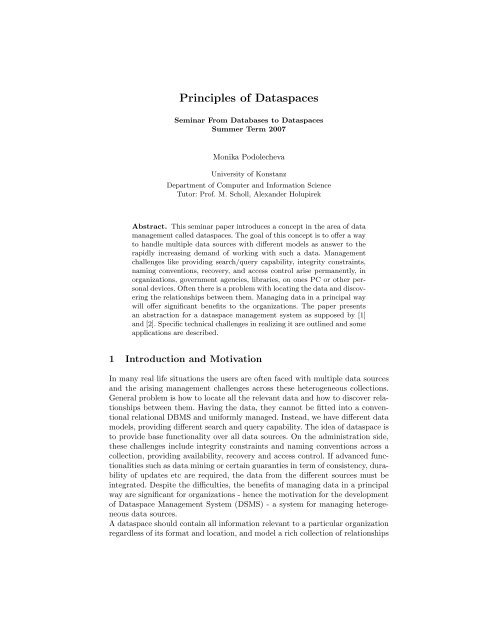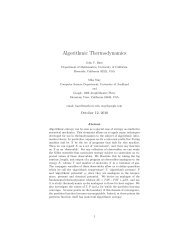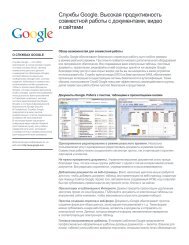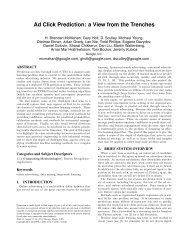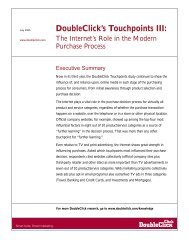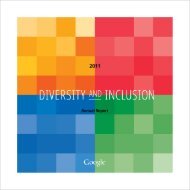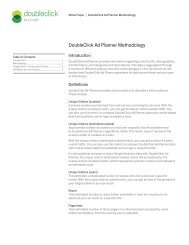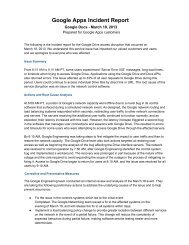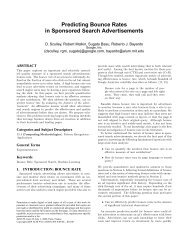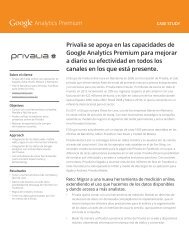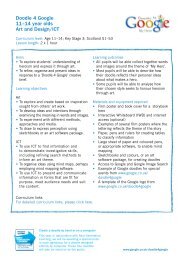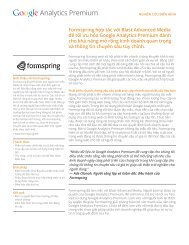Principles of Dataspaces
Principles of Dataspaces
Principles of Dataspaces
You also want an ePaper? Increase the reach of your titles
YUMPU automatically turns print PDFs into web optimized ePapers that Google loves.
<strong>Principles</strong> <strong>of</strong> <strong>Dataspaces</strong> 3which has become a huge data container and thus storage <strong>of</strong> knowledge. Postprocessing<strong>of</strong> data obtained from the web is a challenging issue and requires informationextracting techniques from unstructured, semi-structured and structuredweb documents. Structured documents allow easier access and integration due tothe rich semantically information included in the data representation. Dealingwith semi-structured web pages, the extracted relevant information has to betransformed into structural information and saved local for further processing.Most problematic are the non-structured web documents. Text mining techniquescan be used to map the parsed documents into groups organized with thehelp <strong>of</strong> ontologies, which allow a keyword search.Data Management Extension Some <strong>of</strong> the data underlying models (e. g.simple file server, set <strong>of</strong> web documents) do not provide or provide only limitedmanagement features such as backup, recovery, and replication. Task <strong>of</strong> a DSMSshould be to <strong>of</strong>fer features for enhancing the low level participants. Responsiblefor this task is the Data Management Extension component. Additionally, thiscomponent supports ”value-added” information that is held by the DSMS butnot initially present in the participants, such as translation tables for coded values,classification and rating <strong>of</strong> documents etc. This information must be able tospan the participants. An example is storing connections between presentations,papers and programs, all related to one and the same project.Manager The system should provide an interface between the user and thedataspace participants. The manager is the central component that is responsiblefor the interaction with the user. It manages the user authentication and rightassignment.Discovery Component As mentioned above, a main step in organizing adataspace is to locate the participants and to discover relationships betweenthem. The task <strong>of</strong> the Discovery Component covers these requirements. Initially,it locates participants in a dataspace, usually performing a classification withregard to participant type and content. Then it is responsible for the semiautomaticalcreation <strong>of</strong> relationships, for the improvement and maintenance <strong>of</strong>already existing relationships. This involves finding out which pairs <strong>of</strong> participantsare likely to be related to each other, and then proposing relationships(schema mappings, replicas, etc.) that are afterwards manually verified and refined.Finally, it is important that the discovery component monitors the content<strong>of</strong> the dataspace to propose additional relationships over time.Local Store and Index This component manages the caching <strong>of</strong> search andquery results so that certain queries can be answered without accessing the actualdata. It creates efficiently queryable associations between data objects indifferent participants and improves the access to data sources with limited accesspatterns. The Index has to be highly adaptive to heterogeneous environments.
<strong>Principles</strong> <strong>of</strong> <strong>Dataspaces</strong> 5for user authentication and assignment <strong>of</strong> access rights. Here one can take theadditional Discovery Component as part <strong>of</strong> the Manager. The DSMS does notassume complete control over the data. Instead, it allows the data to be managedby the participant systems, but provides a set <strong>of</strong> services to adjust probablymissing management features. There are three internal data containers, namelythe Metadata Repository (MDR), the Replication Storage (RS), and the LocalStorage and Indexing (LSI) which allow users to transfer data between the componentsand local machines. The information extracted (by the Data Extractor)is locally stored and indexed. The Query Processor faces the problem <strong>of</strong> globalquery on multiple databases at multiple sites. The Query Interpreter translatesthe query into languages supported by the participants.4 ApplicationEcological data analysis The ecological research community is trying to integrateseveral ecological data collected and managed by 27 organizations spreadacross Europe, each <strong>of</strong> them with its own structure, semantic, and metadata description.The goal is to share data on biodiversity, ecology and socio-economyin order to extend their understanding and co-operation. The data sources includedata from different interest domains which are represented as participantswithin the Eco-Dataspace. On demand, the participants could be dynamicallyintegrated into different sub-<strong>Dataspaces</strong> performing different data explorationprocesses, e. g. geostatistics and building prediction models. Within the ApplicationRepository the community will share specialized models and evaluationsthat are very expensive, difficult to develop and, as well as quite resource consumingand thus are distributed among multiple institutions and limited accessible.An integration <strong>of</strong> the results <strong>of</strong> these specialized applications into the Dataspacewill make them ”globally” accessible and available for ecological data analysis.Environmental observation and forecasting Consider a scientific researchgroup monitoring a coastal ecosystem through weather stations, shore-and buoymountedsensors and remote imagery. Consider, they run atmospheric and fluiddynamicsmodels for simulating past, current and future conditions. For thesesimulations they <strong>of</strong>ten need to import data and model outputs from other groups,such as river flows and ocean circulation forecast. On the other side, the results<strong>of</strong> the simulations and the observation serve as input for programs generatinga wide range <strong>of</strong> data products (such as comparison plots between observed andsimulated data and images <strong>of</strong> surface-temperature distributions, etc.). The useris interested in basic file attributes such as time period covered, geographic region,physical variables (temperature, wind speed), kind <strong>of</strong> data product (graph,plot, animation), etc. Information about the version, simulation time step, useddatasets etc. is also required for an appropriate analysis and comparison. Localcopies or additional indices for fast search are neccesarry. Obtaining a hugeamount <strong>of</strong> results, the overview <strong>of</strong> the entire set may get lost. This is a typicallexample for the need <strong>of</strong> DSMS. Following dataspace requirements are illustrated
6 Monika Podolechevahere (and adequate for the former example): a dataspace-wide catalog, supportfor data lineage and creating collections and indexes over entities that span morethan one participating source.Personal Information Management (PIM) PIM should provide easy accessand manipulation <strong>of</strong> all the personal information stored on a desktop, withpossible extension to mobile devices, personal information on the Web, or eveninformation accessed during a person’s lifetime. The idea is to extend the desktopsearch (now limited to keyword queries) using the associations between thedisparate items on the desktop, e. g. ”Compute the aggregate balance <strong>of</strong> mybank accounts”. Additional, we would like to query about sources, e. g. ”Findall the experiments run by student X”. Following principles <strong>of</strong> dataspaces comehere in play: a PIM tool must enable the access to all data, to ensure integration<strong>of</strong> the multiple sources data and to return best-effort results. For realization <strong>of</strong>a PIM systems see iMeMex [8] and SEMEX [9].5 Research ChallengesChallenges in terms <strong>of</strong> Data Models, Querying and Answers : Because<strong>of</strong> the multiple data models that should be supported by a DSMS, methods forinterpreting queries in various languages must be found. Specialized search andquery interfaces and an intuitive visualization <strong>of</strong> the results should be providedto the user, the difference between search and query should remain hidden forhim. There are some specifics regarding the query answers that can be outlinedin the following challenges:– Development <strong>of</strong> intuitive semantics for answering a query that takes intoconsideration a sequence <strong>of</strong> earlier queries leading up to it (allows refinement<strong>of</strong> previous queries)– Development <strong>of</strong> formal model <strong>of</strong> information gathering tasks that include asequence <strong>of</strong> lower-level operations on a dataspace (allows handling or otheractions like browsing, creating content etc)– Development <strong>of</strong> algorithms that will rank the data sources according to howlikely they are to contain the answer 1 .The next point is to shift the attention away from the limited semantic mappingsdeveloping techniques for obtaining the best-effort answers, such as: application<strong>of</strong> several approximate or uncertain mappings and comparison <strong>of</strong> the answersobtained by them; application <strong>of</strong> keyword search techniques for obtaining somedata or some constants that can be used in instantiating mappings; examination<strong>of</strong> previous queries and answers obtained from data sources in the dataspace andensuring mapping between the data sources; having queries that span multipledata sources, finding out how the sources are related (e.g. join attributes should1 For works related to key-word searching, browsing in RDB and ranking: see Hristidiset al. [4], Dbxplorer [5], DISCOVER [6], BANKS [7]
<strong>Principles</strong> <strong>of</strong> <strong>Dataspaces</strong> 7provide some hint <strong>of</strong> common domains). An intuitive challenge concerns theaccuracy <strong>of</strong> the query answers, and extend <strong>of</strong> completeness and precision andlatency required by the user.– Development <strong>of</strong> formal model for approximate semantic mapping and formeasuring the accuracy <strong>of</strong> answers obtained with them.– Definition <strong>of</strong> metrics for comparing the quality <strong>of</strong> answers and answer setsover dataspaces, and efficient query processing techniques.Challenges in terms <strong>of</strong> Uncertainty, Inconsistency and Lineage : Thedata in a dataspace will be uncertain and <strong>of</strong>ten inconsistent. The uncertaintywill increase due to the best-effort query answering. Answers can be different,depending on the level <strong>of</strong> latency and completeness required. Hence, the authorssee as a crucial point that a DSSP must be able to introspect on the answerspresented to the users, and specify the assumptions and lineage underlying them.This section describes some challenges concerning dataspace introspection withrespect to uncertainty, inconsistency and lineage and especially the way theyaffect each other.– Development <strong>of</strong> formalisms that capture uncertainty about common forms<strong>of</strong> inconsistency in dataspaces (e.g. observe where the values come from andhow they were created)– Development <strong>of</strong> formalisms for representing and reasoning about externallineage again in term <strong>of</strong> the uncertainty.– Development <strong>of</strong> a general technique to extend any uncertainty formalismswith lineage, and study the representational and computational advantages<strong>of</strong> doing so (combines the uncertainty and the lineage)Dataspace discovery and reusing human attention : Large enterprises<strong>of</strong>ten do not know which data sources they have. That leads to the problem <strong>of</strong>locating the participants in the dataspace. For discovering relationships betweenthem, clustering and other data mining algorithms must be applied. A goodapproach is to reuse human attention when possible for automatically creation<strong>of</strong> relationships. Consider the following cases: a user have done annotations, havetemporary made collection <strong>of</strong> data for a particular task or written queries on thedata. All this information can be exploited by machine learning techniques togain knowledge about the relationships between the dataspaces. Methods foranalyzing users’ activities when interacting with a dataspace and creation <strong>of</strong>additional meaningful relationships in a dataspace or other enhancements to thedataspace are needed. The following challenges result from the nature <strong>of</strong> thehuman interaction:– Development <strong>of</strong> techniques that examine collections <strong>of</strong> queries over datasources and their results to build new mappings between disparate datasources.– Development <strong>of</strong> algorithms for grouping actions on a dataspace into tasks.
8 Monika Podolecheva– Development <strong>of</strong> facilities for explicit enhancement <strong>of</strong> dataspace informationthat give high return on the investment <strong>of</strong> human attention.– Development <strong>of</strong> a formal framework for learning from human attention indataspacesChallenges in terms <strong>of</strong> dataspace storage and indexing : Indexing ischallenging due to the heterogeneity <strong>of</strong> the data. It should uniformly index allpossible data regardless <strong>of</strong> their data model. Further, the index needs to considermultiple ways <strong>of</strong> referring to the same realworld object. A problem will be to keepthe index up to date, especially for participants that do not have mechanisms tonotify <strong>of</strong> updates.6 ConclusionsThe dataspaces were presented as a solution for the uniform management <strong>of</strong>disparate data sources. Requirements on the DSMS components were discussedto give a more concrete idea <strong>of</strong> the suggested system. Besides the benefits, thereare many open points that have to be considered. Some <strong>of</strong> the challenges arealready under research, others are still pure abstraction. Seamless querying <strong>of</strong>heterogeneous data is one <strong>of</strong> the main problems. Further, the data are not underfull control <strong>of</strong> the system, which leads to a lack <strong>of</strong> limited ACID guarantees.Well functioning DSMS are needed and will be very valuable in many contexts,however, it will take a lot <strong>of</strong> time and research to overcome the challenges facedwith heterogeneity.References1. Halevy, M. Franklin and D. Maier: <strong>Principles</strong> <strong>of</strong> Dataspace Systems, 2006ACM1595933182/06/00062. Ibrahim Elsayed and Peter Brezany, A Min Tjoa: Towards Realization <strong>of</strong> <strong>Dataspaces</strong>Proceedings <strong>of</strong> the 17th International Conference on Database and Expert SystemsApplications (DEXA’06) 0-7695-2641-1/06, 2006 IEEE3. M. Franklin, A. Halevy and D. Maier: From Databases to <strong>Dataspaces</strong>: A New Abstractionfor information Management, 2005 SIGMOD Record, Vol. 34, No. 4, Dec.20054. V. Hristidis,L. Gravano,Y. Papakonstantinou: Efficient IR-Style Keyword Searchover Relational Databases VLDB, 20035. S. Agrawal, S. Chaudhuri, and G. Das: Dbxplorer: A system for keyword-basedsearch over relational databases, 2002 Proceedings <strong>of</strong> ICDE, 2002.6. V. Hristidis, Y. Papakonstantinou: DISCOVER: Keyword search in relational databases,VLDB 20027. G. Bhalotia, C. Nakhey, A. Hulgeri, S. Chakrabarti, and S. Sudarshanz: KeywordSearching and Browsing in Databases using BANKS Proceedings <strong>of</strong> ICDE, 20028. Jens-Peter Dittrich: iMeMex: A Platform for Personal Dataspace Management 2ndInvitational Workshop for Personal Information Management, 20069. Yuhan Cai, Xin Luna Dong, Alon Halevy, Jing Michelle Liu, and Jayant Madhavan:Personal Information Management with Semex SIGMOD 2005 June


